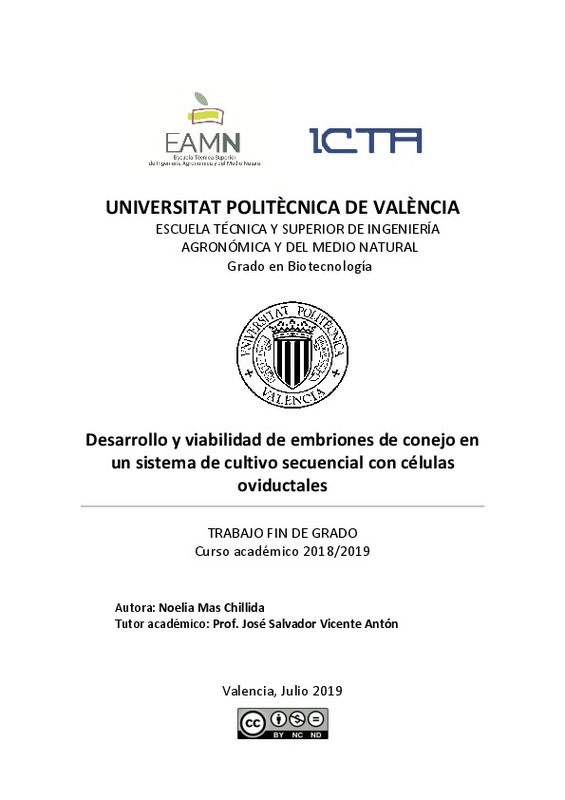|
Resumen:
|
[ES] El ambiente en que tiene lugar el desarrollo embrionario tiene una gran influencia en el mismo,
tanto a corto como a largo plazo; durante los primeros estadios de desarrollo destaca el
oviducto como pieza fundamental, ...[+]
[ES] El ambiente en que tiene lugar el desarrollo embrionario tiene una gran influencia en el mismo,
tanto a corto como a largo plazo; durante los primeros estadios de desarrollo destaca el
oviducto como pieza fundamental, ya que se trata del medio que aporta todos los factores y
componentes necesarios para la correcta regulación y comunicación materno-embrionaria. Se
conoce la importancia del mecanismo pero existe un vacío traslacional entre lo que sucede in
vivo y el análisis in vitro, es por lo que en este estudio se ha comprobado el efecto de la
temperatura, un sistema de cultivo secuencial y el co-cultivo con células oviductales de conejo
sobre el desarrollo temprano de embriones de conejo.
En primer lugar se evaluó el efecto del medio y la temperatura sobre el desarrollo en
embriones de conejo, utilizando un medio simple esencial (MEM) suplementado con piruvato y
lactacto sódico o con suero en un método continuo y un medio suplementado con piruvato y
lactato sódico en un medio secuencial. Tras 96h de cultivo se analizaron los patrones de
expresión génica de factores de pluripotencialidad como el OCT4, NANOG y SOX2 para evaluar
la calidad de los embriones obtenidos. Se determinó que el medio MEM suplementado con
piruvato y lactato sódico en cultivo continuo y la temperatura de 38.5 ºC favorecía el desarrollo
embrionario hasta blastocisto, permitiendo la eliminación del suero en el medio de cultivo. Se
observó que los distintos medios no modificaban los patrones de expresión mientras que la
temperatura sí lo hacía. Estos cambios se atribuyeron a la relación entre los niveles de
expresión y el estadio de desarrollo embrionario alcanzado, siendo una mayor expresión en
embriones con menor desarrollo y una menor expresión en aquellos embriones con mayor
desarrollo y por tanto de mayor calidad.
Con estas premisas se llevó a cabo la segunda parte del estudio, en la que se evaluó la eficacia
del co-cultivo con células epiteliales de oviducto cunícula (ROECs) en las condiciones
establecidas como óptimas (MEM suplementado con piruvato y lactato sódico a 38.5 ºC). Se
determinó que la presencia de las células oviductales mejoraba la tasa de obtención de
blastocistos sin modificar el patrón de expresión.
[-]
[EN] The environment where happen the early embryo development has a great influence itself, in
the short and long term; at the first stages the oviduct is being involved in an important role,
which is supply the environment ...[+]
[EN] The environment where happen the early embryo development has a great influence itself, in
the short and long term; at the first stages the oviduct is being involved in an important role,
which is supply the environment with all the factors needed for the right regulatory
mechanisms and maternal-embryo communication. Moreover, it is known the importance of
the process but there is an empty between what happens in vivo and the analysis in vitro. The
aim of this study was evaluate the effect of the temperature, type of culture (continuous or
sequential) and the co-culture with oviduct epithelial cells (ROECs) in order to mimic the
environment in vivo on early development of rabbit embryos.
The effect of the medium and temperature on development in rabbit embryos were evaluated,
using an essential simple medium (MEM) supplemented with pyruvate and sodium lactate or
with serum in a continuous method and a medium supplemented with pyruvate and sodium
lactate in a sequential medium. After 96h of culture, the gene expression patterns of
plurypotency factors such as OCT4, NANOG and SOX2 were analyzed to evaluate the quality of
obtained embryos. It was determined that the MEM medium supplemented with pyruvate and
sodium lactate in continuous culture and the temperature of 38.5 ºC favored the embryonic
development until blastocyst, allowing the elimination of the serum in the culture medium. It
was observed that the different media did not modify the expression patterns while the
temperature did. These changes were attributed to the relationship between expression levels
and the stage of embryonic development reached, with greater expression in embryos with less
development and lower expression in those embryos with greater development and therefore,
of higher quality.
The second part of the study was carried out evaluating the efficacy of co-culture with rabbit
oviduct epithelial cells (ROECs) under the conditions established as optimal (MEM
supplemented with pyruvate and sodium lactate at 38.5 ºC). It was determined that the
presence of oviductal cells improved the rate of obtaining blastocysts but the pattern of gene
expression was not modified.
[-]
|







